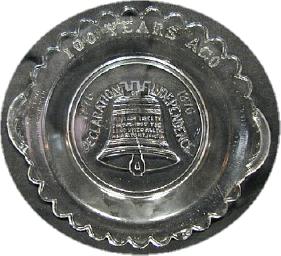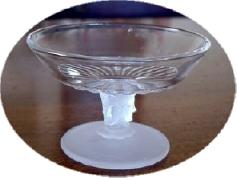National Depression Glass Association
Preserving America's Glass Manufacturing Heritage
Pattern Glass
by Jim Bridgham
Rainbow Review Glass Journal - May 1973
Pattern glass was the depression glass of its era. It was the common, everyday tableware, inexpensive to produce and to own. Much of the history of pattern glass is lost because no one considered it worthy of preservation. But there is no doubt that Deming Jarves of the Boston and Sandwich Glass Company deserves credit for developing the machinery to mechanize the glass industry.
Pressed glass furniture knobs and bases for bowls were being made in
England and Europe as early as 1815, and in this country shortly after.
Tableware was another matter. It was all hand blown, and so costly that
only the wealthy could afford it. Deming Jarves' method of pressing
 glass by using a plunger to force the metal (molten glass) into an iron
mold was patented in 1828 and by 1840, glass production on a large
scale had been achieved.
glass by using a plunger to force the metal (molten glass) into an iron
mold was patented in 1828 and by 1840, glass production on a large
scale had been achieved.
The earliest pressed glass was the lacy type. It was made from metal with a high lead content, and dependent on the stippled effect in the patterns to produce the sheen and disguise the crudities of the molds. As both the molds and the metals were improved, the pattern designers copied the cut glass styles, and glass became plainer, but still had the ring which we associate with fine crystal today.
Competition within the industry was intense. Manufacturers
constantly sought new patterns to attract the consumer's interest, and
there was much copying of successful designs. Patterns became more
 naturalistic and effects possible only in molded glassware were sought.
The development of lime glass in the 1860s both lowered costs and
spurred the production of colored glass in volume.
naturalistic and effects possible only in molded glassware were sought.
The development of lime glass in the 1860s both lowered costs and
spurred the production of colored glass in volume.
Some of the most interesting and popular patterns were designed during the 1870s. Lion, Three Face (photo at left), Westward Ho, and Liberty Bell (photo above right) are still prized today, as are many others. Liberty Bell was produced to celebrate the Centennial, and the bread plate features the names of the signers of the Declaration of Independence around the border.
In keeping with the spirit of the times, the glass industry expanded westward. Gas was available for fuel, and the price advantage that this gave to a western plant was the doom of the eastern companies.
At the turn at the century, mold makers went back to copying their patterns from the cut glass so popular then. Designs became ornately geometric. As production costs rose, the variety of patterns and the number of pieces made in each one necessarily declined. Fashions in tableware changed, and pattern glass gradually disappeared from the scene.